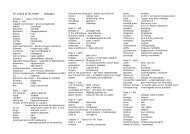STUDENTEREKSAMEN ENGELSK A-NIVEAU
STUDENTEREKSAMEN ENGELSK A-NIVEAU
STUDENTEREKSAMEN ENGELSK A-NIVEAU
Create successful ePaper yourself
Turn your PDF publications into a flip-book with our unique Google optimized e-Paper software.
TEXT 3<br />
Sir Edmund Hillary<br />
50 Years - My Story<br />
Side 7 af 11 sider<br />
The New Zealand mountaineer Edmund Hillary and his Sherpa guide Tenzing Norgay were the first humans to reach<br />
Earth's highest point: the summit of Mount Everest in the Himalayas on May 29, 1953. Hillary was knighted for his<br />
feat and in later years led expeditions to the South Pole and to the source of the Yangtze River. He also committed<br />
himself to humanitarian work among the Sherpas through his Himalayan Trust.<br />
In the following excerpt from an article in National Geographic Edmund Hillary recalls 50 years on top of the world.<br />
Ever since the morning of May 29, 1953, when Tenzing Norgay and I became the first<br />
climbers to step onto the summit of Mount Everest, I've been called a great adventurer.<br />
The truth is, I'm just a rough old New Zealander who has enjoyed many challenges in<br />
his life. In fact, as I look back after 50 years, getting to the top of Everest seems less<br />
5 important, in many ways, than other steps I've taken along the way - steps to improve<br />
the lives of my Sherpa friends in Nepal and to protect the culture and beauty of the<br />
Himalaya.<br />
Not that I wasn't excited to reach the top of the world. I remember when Tenzing and<br />
I faced the icy, narrow final ridge to the summit. Some on our team had predicted the<br />
10 ridge would be impossible to climb, but it didn't look so bad to us. After attaching fresh<br />
oxygen bottles to our masks, we set off. I led the way, hacking a line of steps with my<br />
ice axe. After about an hour we came to a 40-foot-high rock buttress barring our path -<br />
quite a problem at nearly 29,000 feet. An ice cornice was overhanging the rock on the<br />
right with a long crack inside it. Beneath the cornice the mountain fell away at least<br />
15 10,000 feet to the Kangshung Glacier. Would the cornice hold if I tried to go up? There<br />
was only one way to find out.<br />
Jamming my crampons into the ice behind me, I somehow wriggled my way to the<br />
top of the crack, using every handhold I could find. For the first time I felt confident<br />
that we were going to make it all the way. To the right I saw a rounded snow dome and<br />
20 kept cutting steps upward. In less than an hour I reached the crest of the ridge, with nothing<br />
but space in every direction. Tenzing joined me, and to our great delight and relief<br />
we stood on top of Mount Everest.<br />
[...]<br />
So over the years I've done lots of expeditions and projects in remote parts of the<br />
world - some big ones and many small ones. I've stood at both the North and South<br />
25 poles as well as on the world's highest peak. When I look back over my life, though, I<br />
have little doubt that the most worthwhile things I have done have not been getting to<br />
the summits of great mountains or to the extremes of the earth. My most important<br />
projects have been the building and maintaining of schools and medical clinics for my<br />
dear friends in the Himalaya and helping restore their beautiful monasteries too.








